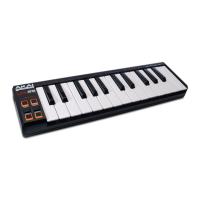
Do you have a question about the Akai Professional LPK25 and is the answer not in the manual?
| Number of Keys | 25 |
|---|---|
| Connectivity | USB |
| Arpeggiator | Yes |
| Octave Shift | Yes |
| Sustain Button | Yes |
| Pitch Bend | No |
| MIDI I/O | USB |
| Compatibility | Mac, PC |
| Key Type | Mini |
| Power Source | USB |
| Type | MIDI controller |
Instructions for installing Akai Professional LPK25 Editor software on PC.
Instructions for installing Akai Professional LPK25 Editor software on Mac.
Connects LPK25 to computer for power and data transfer via USB.
The 25-note velocity-sensitive keyboard, controllable with octave buttons.
Button to enable or disable the Arpeggiator function.
Allows setting the Arpeggiator tempo by tapping.
Sustain holds notes; Latch continues arpeggiation after key release.
Recalls presets by pressing with numbered keyboard keys.
Shifts the keyboard's range up or down by four octaves.
Steps to connect the LPK25 and open the software editor on PC and Mac.
Describes how to load, save, and commit presets to the LPK25.
Procedure to copy a preset from the LPK25 to another preset slot.
Selects the MIDI channel the LPK25 uses for transmitting messages.
Changes the keyboard's pitch transposition up to 12 semitones.
Selects the default octave setting for the current preset.
Defines the octave range (0-3) for arpeggiated notes.
Toggles the Arpeggiator function on or off.
Sets the arpeggio pattern (Up, Down, Inclusive, Exclusive, Order, Random).
Determines the timing of notes played by the Arpeggiator.
Selects between internal or external clock for the Arpeggiator.
Enables or disables latching for the Arpeggiator function.
Sets the minimum number of taps for the Tap Tempo button.
Adjusts the tempo of the Arpeggiator using mouse or keys.
Details MIDI channels, note numbers, program changes, and supported modes.
Indicates if Note-On Velocity is supported.
Lists support for various Universal System Exclusive messages.
Lists support for Manufacturer or Non-Commercial System Exclusive messages.
Details MIDI Clock, Song Position Pointer, Start, Continue, Stop, and MIDI Time Code support.
Details compatibility with General MIDI, DLS, Standard MIDI Files, XMF, and SP-MIDI.
Indicates that the device has 4 presets.
Details the number of MIDI output channels available via USB.
Specifies the number of keys and their velocity sensitivity.
Details the available input/output ports.
Specifies the power consumption and voltage via USB.
Provides the physical dimensions of the device.
Indicates the total weight of the device.